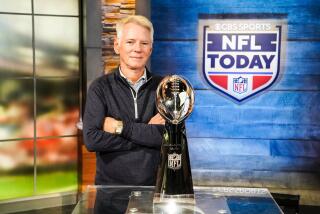Rivals, and Friends?
To hear the executives at Sirius and XM talk, peace has broken out in the world of satellite radio.
The president of XM Satellite Radio Holdings Inc., Hugh Panero, was the first to make nice.
In November, when Sirius Satellite Radio Inc. hired Mel Karmazin as chief executive, Panero publicly welcomed the former Viacom Inc. executive, saying he brought âa new level of maturityâ to the fledgling industry.
Karmazin, whose move into mostly commercial-free, subscriber-based satellite radio capped a career built largely in the traditional AM/FM market, was quick to reciprocate.
âThere was a time when both companies thought of each other as the enemy,â Karmazin said in a recent interview. âThatâs not my viewpoint today. Our real competition is terrestrial radio.â
Some analysts are heartened by the apparent cease-fire. For more than a decade, media gurus have said satellite radio would revolutionize broadcast music the way cable upended television. But although XM and Sirius have spent hundreds of millions of dollars in the competition for subscribers, satellite radio has failed to lure more than 3% of the nationâs 229 million radio listeners.
When trying to persuade people to pay $12.95 a month for a medium they already get for free, a truce makes good business sense.
But is it for real?
âKarmazin and Panero are both very competitive,â said Tom Eisenmann, a professor at Harvard Business School, who is watching the outbreak of collegiality with skepticism. âNeither of them want to be in second place.â
That competition, say some investors, has been a problem since 1997, when Sirius and XM were the sole winners of Federal Communications Commission satellite radio licenses. Soon after, both rushed to launch satellites capable of nationwide broadcasts to specially designed radios.
New York-based Sirius was first in orbit, launching three satellites by 2000. But then the company stumbled, choosing to outsource development of key components and disappointing investors with repeated delays.
Washington-based XM rushed into the breach, beginning broadcasts in 2001 to almost 30,000 paying listeners. When Sirius finally began transmitting, in 2002, it took the company six months to lure an equal number of subscribers.
Since then, each company has spent billions of dollars building networks that carry more than 120 channels apiece. Each has touted its ability to offer listeners more choice and eclectic channels -- such as all Elvis, all the time -- with no or few advertising interruptions.
And at least until recently, each had readily predicted the otherâs demise.
In January, XM-friendly hecklers shouted down the Sirius chief at an industry conference, forcing Karmazin to yell at them to shut up. XM executives, meanwhile, have pointed to Siriusâ lush Rockefeller Center headquarters as a symbol of what they see as the companyâs profligate ways.
For their part, Sirius employees have whispered to analysts that the XM headquarters, a former warehouse, is better suited to the dead pigeons and broken glass it once housed, and that its current residents are aging DJs and tone-deaf executives.
Such head-to-head competition has forced each company to stake out its own strategy.
Although XM has made some investments in high-priced content, it has staked its future more on developing technology and forming partnerships with automakers to make its service easier to buy.
The company scored early with an alliance with General Motors Corp. The automaker began factory-installing the companyâs radios in Cadillacs, Chevrolets and other cars in 2001. The deal was expensive, costing XM $440 million through 2013.
Sirius rushed to catch up, developing exclusive relationships with BMW, Ford Motor Co., Mitsubishi and DaimlerChrysler. But until recently those car companies didnât make it as convenient as General Motors did for customers to purchase satellite radios.
Sirius also has lagged behind its competitor in technology: Last year, XM made it to market with a portable mini-radio receiver, MyFi, that lets users listen while jogging. Sirius has not released a similar product, although the company expects to by the end of this year.
Sirius is banking on a different tack: investing heavily in big-name talent and the publicity that comes with it. First, it hired shock jock Howard Stern, who will make $500 million over five years.
Karmazin has said that if 1 million Stern fans subscribe to the service, it will recoup that investment. Some analysts put the break-even figure at closer to 2 million subscribers.
After signing Stern, the company snapped up major sports franchises, adding the National Basketball Assn. alongside a previous contract with the National Football League. Sirius also signed contracts with singers such as Jimmy Buffett and Eminem to choose playlists for channels titled âRadio Margaritavilleâ and â Shade 45,â respectively.
Karmazin even stole away NASCAR, signing a $107.5-million contract to broadcast the racing franchise for five years when its contract with XM expires in 2007.
Recent subscriber tallies suggest both companiesâ strategies are working. XM added 68% more subscribers in the first quarter of 2005 than in the same period of 2004, giving the company 3.7 million listeners. Since then, XM has added 700,000 subscribers.
Siriusâ new additions in the first quarter increased by 237% over the same period in the previous year, to more than 1.45 million subscribers. The company has not released its second-quarter subscriber figures.
But the tactics have proved costly, driving up marketing costs and the price of on-air talent. Sirius will be responsible for fixed costs of as much as $200 million a year when its most recently signed content contracts begin, although company sources said the NFL agreement, which is valued at more than $220 million over seven years, is structured so that major expenses are not borne until the contractâs conclusion.
XM, meanwhile, emerged the victor in Octoberâs bidding war for Major League Baseball. But the company paid dearly, forking over $650 million to broadcast the next 11 years of games.
So it is no surprise that neither company has ever made a profit.
âThe best situation would have been if these companies had worked together from the beginning,â said Jonathan Jacoby of Banc of America Securities. âThey need to stop trying to spend each other out of existence and instead cooperate on attracting new listeners.â
In April, it appeared they were beginning to do just that when XM declined to counter Siriusâ $30-million bid to create a channel with lifestyle entrepreneur Martha Stewart.
Many saw XMâs decision to pass on Stewart as evidence of a new spirit of friendliness.
But in a recent interview, Panero sounded more cocky than friendly.
âWe werenât interested,â he said of the Stewart pitch. âMartha is visual product. Her magazine, her TV show, itâs all visual. It isnât going to translate to radio.â
Instead, XM is going to develop a womenâs channel in-house, he said, âand thereâs no question weâll beat Sirius at attracting more female subscribers.â
David Frear, Siriusâ chief financial officer, disagreed. He too did not appear to be holding his fire.
âXM made a huge mistake in letting us get Martha Stewart,â Frear said. âWeâll eventually have the same technology as XM, and we have very similar partnerships with automakers. The only difference that matters will be content, and we have the biggest name in womenâs programming.â
There are other signs of cracks in the companiesâ supposed unified front. Jacoby notes that recent promotions in which each company has sought to undercut the otherâs prices on radio units might be construed as destructive competition.
Jacoby said surveys conducted by his firm indicated that the cost of subscribing to satellite radio was the key determinant in encouraging listeners to try the service. The price of the radio unit itself, he said, has much less influence on attracting new listeners.
âThose units are discounted because the companies are fighting over who gets the subscription,â Jacoby said.
Ultimately, although executives at both companies assert they want to end destructive competition, that may not be possible until one of them cedes the game.
Eisenmann, the Harvard professor, said there comes a time in any two-player rivalry when decreased competition is advantageous to both. In markets where there are two large fast-food chains, for example, the companies have been accused of driving out competitors and then hiking up prices. In the rental car market, Avis turned its No. 2 status into a marketing campaign: âWe try harder.â
âThereâs a natural point when duopolies can de-escalate competition. Otherwise, they might destroy each other,â Eisenmann said. But for that to occur, he added, âyou must have credibility and trust between the competitors. And someone must be content to be No. 2.â
So far, however, neither XM nor Sirius has embraced such a position. To hear the executives talk, both want to be Hertz.
âNobody gets into this game to be in second place,â Panero said.
Karmazin agreed. âThere will be a Coke and Pepsi comparison,â he said. âBut weâre going to be the bigger one. I have no interest in running Pepsi.â
So much for the truce.
*
(BEGIN TEXT OF INFOBOX)
Sirius
Its focus has been on content, investing heavily in talent and the publicity that comes with it. The service has more than 120 channels.
Whom it has signed
Howard Stern: The veteran radio talk show host and star inked a $500-million, five-year contract.
Eminem: The mega-selling rap singer will produce Siriusâ hip-hop channel, Shade 45.
Martha Stewart: The lifestyle entrepreneur whoâs currently finishing house arrest was paid $30 million for a four-year contract.
Lance Armstrong: Cycling star and Tour de France champion
Bill Bradley: Former U.S. senator and presidential candidate
Tony Hawk: Skateboarding celebrity
*
Sports
NASCAR broadcast rights starting in 2007 were worth $107.5 million to the network.
National Football League broadcast rights cost Sirius more than $220 million for a seven-year contract.
--
(BEGIN TEXT OF INFOBOX)
XM
Its focus has been on technology and getting its radios factory-installed in cars. The service has more than 150 channels.
Whom it has signed
Bob Edwards: Former anchor of NPRâs âMorning Editionâ
Snoop Dogg: The rapper will be the host of a 90-minute program from his home.
Dr. Laura Schlessinger: Talk radio personality and self-help author
G. Gordon Liddy: Radio talk show host and former aide to Richard Nixon
Cal Ripken Jr.: Legendary Baltimore Oriole shortstop
*
Sports
NASCAR through 2006
Major League Baseball cost the network $650 million for an 11-year contract.
More to Read
The biggest entertainment stories
Get our big stories about Hollywood, film, television, music, arts, culture and more right in your inbox as soon as they publish.
You may occasionally receive promotional content from the Los Angeles Times.










